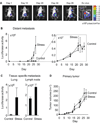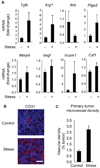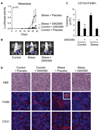The sympathetic nervous system induces a metastatic switch in primary breast cancer
- PMID: 20823155
- PMCID: PMC2940980
- DOI: 10.1158/0008-5472.CAN-10-0522
The sympathetic nervous system induces a metastatic switch in primary breast cancer
Abstract
Metastasis to distant tissues is the chief driver of breast cancer-related mortality, but little is known about the systemic physiologic dynamics that regulate this process. To investigate the role of neuroendocrine activation in cancer progression, we used in vivo bioluminescence imaging to track the development of metastasis in an orthotopic mouse model of breast cancer. Stress-induced neuroendocrine activation had a negligible effect on growth of the primary tumor but induced a 30-fold increase in metastasis to distant tissues including the lymph nodes and lung. These effects were mediated by β-adrenergic signaling, which increased the infiltration of CD11b(+)F4/80(+) macrophages into primary tumor parenchyma and thereby induced a prometastatic gene expression signature accompanied by indications of M2 macrophage differentiation. Pharmacologic activation of β-adrenergic signaling induced similar effects, and treatment of stressed animals with the β-antagonist propranolol reversed the stress-induced macrophage infiltration and inhibited tumor spread to distant tissues. The effects of stress on distant metastasis were also inhibited by in vivo macrophage suppression using the CSF-1 receptor kinase inhibitor GW2580. These findings identify activation of the sympathetic nervous system as a novel neural regulator of breast cancer metastasis and suggest new strategies for antimetastatic therapies that target the β-adrenergic induction of prometastatic gene expression in primary breast cancers.
©2010 AACR.
Figures






References
-
- Thaker PH, Han LY, Kamat AA, Arevalo JM, Takahashi R, Lu C, et al. Chronic stress promotes tumor growth and angiogenesis in a mouse model of ovarian carcinoma. Nat Med. 2006;12:939–944. - PubMed
-
- Tang Y, Shankar R, Gamelli R, Jones S. Dynamic norepinephrine alterations in bone marrow: evidence of functional innervation. J Neuroimmunol. 1999;96:182–189. - PubMed
-
- Cakir Y, Plummer HK, 3rd, Tithof PK, Schuller HM. Beta-adrenergic and arachidonic acid-mediated growth regulation of human breast cancer cell lines. Int J Oncol. 2002;21:153–157. - PubMed
Publication types
MeSH terms
Grants and funding
LinkOut - more resources
Full Text Sources
Other Literature Sources
Research Materials
Miscellaneous

